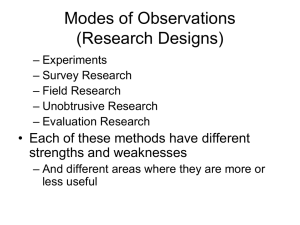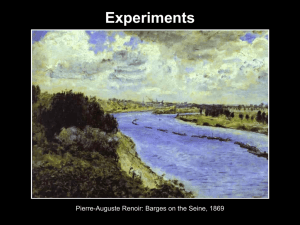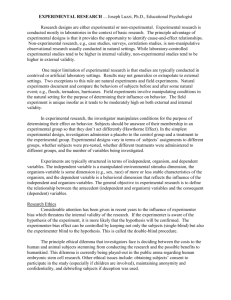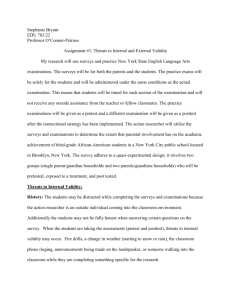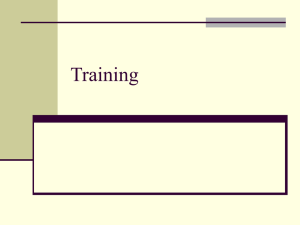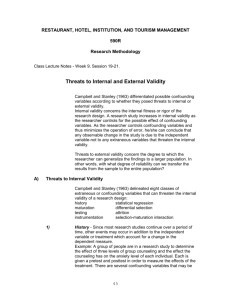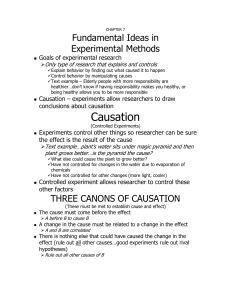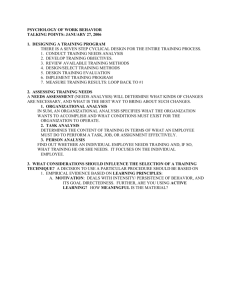random assignment
advertisement
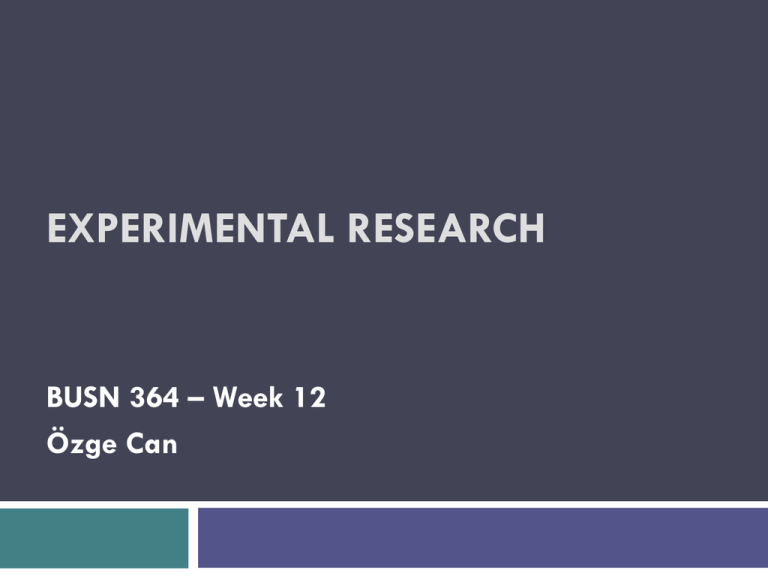
EXPERIMENTAL RESEARCH BUSN 364 – Week 12 Özge Can Stanford Marshmallow Experiment Measuring delayed gratification (ability to wait in order to obtain something you want) http://www.youtube.com/watch?v=x3S0xS2hdi4 A child is given a marshmallow and promised another, only if they could wait before eating the first one. Researchers measure how long the child resists the temptation of eating it Whether correlated with future success or not Experimental Research Builds on the principles of positivist perspective and natural sciences (1) Starts with a causal hypothesis (2) Modify one specific aspect of a situation that is closely connected to the cause, and (3) Compare the outcome to what existed without the modification Example Experiment Manipulation of Independent Variable Question: Do suggestions affect memories? Method: Randomly assign participants to groups and tell some participants that dreams indicate prior experience but do not tell that to other participants. Results: Dream interpretations induce changes in memories of past events. Conclusion: We can influence people’s memories by giving them erroneous information Attributes of Experiments Can powerfully test causal relationships An experiment is often artificial => includes independent and dependent variables but exclude confounding variables Confounding Variables: Factors that are not part of the intended hypothesis but have effects on variables of interest Best for issues that have a narrow scope and sharpened focus Attributes of Experiments Isolates and targets one or a few causal variables; not effective for considering dozens of variables simultaneously Best suited for micro-level (individuals, small-groups) more than macro-level (entire society) theoretical concerns Practical and ethical limitations in social science experiments => We cannot manipulate many areas/conditions of human life Power of Experimental Design Is it better to study these with a survey or experiment? Playing violent video games increases aggressive behavior Students who sit at the front of the classroom make better grades than those that sit in the back Power of Experimental Design Consider recent changes that have been made on your campus (e.g., changes in graduation requirements or student life issues). Did the administration use experiments or quasiexperiments to determine whether or not to make these changes? Can you think of situations in which an experimental approach could have been used? Parts of the Experiment 1. 2. 3. 4. 5. 6. 7. Treatment or independent variable (IV) Dependent variable (DV) Pretest Posttest Experimental group Control group Random assignment Parts of the Experiment Treatment => (stimulus, manipulation) the independent variable or a combination of independent variables in experimental research Dependent variable => the outcome in experimental research. It is measured by paper-and-pencil tests, observation, interviews or physiological responses (e.g. heart beat, palm sweating) Pretest => the measurement of the independent variable prior to the introduction of the treatment. Parts of the Experiment Posttest => the measurement of the independent variable after the treatment has been introduced into the experiment situation Experimental group => the group that receives the treatment or in which treatment is present Control group => the group that does not receive the treatment Random Assignment Participants divided into groups at the beginning of experimental research using a random process so the experimenter can treat the groups as equivalent Randomness in statistical or mathematical sense: All participants have an equal chance of ending up in one or the other group Increases our confidence that the groups do not differ in any systematic way Random Assignment How to Randomly Assign? Controls in Experiment By controlling confounding effects and isolating the effects of the treatment, we eliminate alternative explanations Deception: Sometimes we intentionally mislead participants to control the experiment setting Deception involves using confederates and cover stories (as false explanations) Using placebo: simulated or ineffectual treatment intended to deceive the participants Blind studies: Single blind; double-blind Steps in Experiment (1): • • • • • Hypothesis Choose a design Design experiment – How to introduce IV – How to measure DV Locate subjects Randomly assign subjects Steps in Experiment (2): • • • Gather pretest data Run experiment – Introduce treatment – Measure DV – Gather posttest data – Debrief Analyze data Types of Experimental Design Classical Experimental Design: Includes random assignment, a control group and experimental group, and a pretest and posttest for each group Pre-Experimental Design: Lack control group and random assignment Weaker than classical experiment Substitude classical experiments when they are not possible Types of Experimental Design Quasi-Experimental Design We call them “quasi” (apparently, as if) becuse they are variations of the classical design Some have control group and randomization but lack a pretest Types of Experimental Design Classical Experimental Design Figure 8.6 Pretest-posttest control-group design. Classical Experiment: Example You have 40 newly hired waiters; you instruct them not to introduce themselves with first name and not to return during the meal to check on the customers You randomly divide the waiters into two groups of 20 persons (random assignment) and send each group to one of two restaurants to begin working. You record the amount of tips for all participants for one month (pretest score) Classical Experiment: Example Next, you retrain the group at restaurant A (experiment group) and instruct them to introduce themselves with first name and ask “Is everything fine?” 10 minutes after delivering the food (treatment). You remind the group at restaurant B (control group) to continue as before. Over the second month, you record the amount of tips for both groups (posttest score) Internal Validity Occurs when the independent variable, and nothing else, influences the dependent variable. Anything other than independent variable threatens internal validity Artifacts => unwanted or confounding variables that are due to the particular experimental arrangement Threats to Internal Validity Selection bias A bias that arise when groups in an experiment are not equivalent with regard to the DV History Something occurs and affects the DV during an experiment; is unplanned and outside the researcher’s control Maturation Natural processes of growth, boredom, fatigue that occur during the experiment and affect DV Threats to Internal Validity Testing: The very process of measuring, the pretest measure itself has an effect on DV Instrumentation: Occurs when the instrument or measure of the DV changes during the experiment Experimental mortality Participant fail to participate throughout the entire experiment; they leave the experiment Demand characteristics Participants “guess” the study hypothesis and respond to what they think the experimenter “demands” from them Threats to Internal Validity Diffusion of treatment The treatment “spills over” from the experimental group and control group participants modify their behavior because they learn of the treatment Compensatory behavior When participants in the control group modify their behavior to make up for not getting the treatment Experimenter Experimenter expectancy indirectly makes participants aware of the hypothesis or desired results External Validity The ability to generalize experiment findings It addresses two major questions: 1. Can we generalize from the specific collection of participants in one experiment to an entire population => Population generalization 2. Can we generalize from what occurs in a highly controlled and artificial setting to most natural, “real world” situations => Naturalistic generalization External Validity Field Experiments An experiment that takes place in the “field”; a natural setting instead of an artifical one (laboratory) They have lower internal validity but higher external validity than laboratory experiments Participants are usually unaware that they are involved in an experiment and react in a natural way Example: A confederate fakes a heart attack on the subway to see how the bystanders react Field Experiments Helping behavior and gender http://www.youtube.com/watch?v=BuyIOM4d- OA&feature=related Practical Considerations Planning and pilot testing We anticipate alternative explanations or threats to internal validity during a good planning phase Instructions to subjects Preparing instructions carefully so that all participants understand the exact same thing Post-experiment interview Ethically debriefing research participants the deception; understanding what participants thought and felt during the experiment Online Resources: This University of Denver site provides links to various online experiments in which students can participate. http://www.du.edu/psychology/methods/ Watch it Super Size Me Field experiment by Morgan Spurlock (2004) http://www.youtube.com/watch?v=4QezCOCVmg&feature=relmfu
